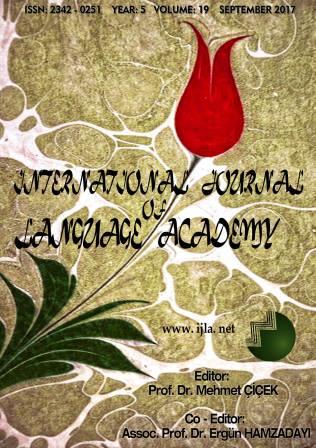Author :
Abstract
Bir milletin geçmişten günümüze dek getirdiği maddi ve manevi her şey, o milletin kültürünü oluşturur. Kültürün nesilden nesile aktarılmasında en önemli araç olan dil, kültürün en temel ögesidir. Bir milleti her yönüyle bize aktaran dil, ulusların yaşam biçimini, inanışlarını, tarihini yansıtan en önemli aynadır. Bu bağlamda, bir toplumu anlamak için o toplumun kullandığı dilin incelenmesi gerekir. Dil, esasında seslerden oluşuyor olsa da dili anlamlı kılan, seslerin bir araya gelerek anlam kazanmasıdır. Sesleri bir araya getirerek sözcükleri, sözcükleri bir araya getirerek de cümleleri oluştururuz. Sözcüklerin bir araya gelerek anlamlı gruplar oluşturması dilin en önemli özelliğidir.Her dilde olduğu gibi Türkçede de en az iki sözcüğün bir araya gelerek oluşturduğu dil birlikleri vardır. En az iki sözcüğün birleşmesiyle oluşan, bir araya geldiklerinde ortaya çıkan anlamın tamamen dışında yeni bir anlam ifade eden ve süreç içinde kalıplaşan söz gruplarına deyim denir. Atasözleri; toplumların asırlarca süren deneyimlerinden ve gözlemlerinden elde ettikleri yargılarını, ortak düşünce ve tutumlarını yansıtan; içinde mecazi bir anlam barındıran, eğitici ve öğretici niteliği bulunan kalıplaşmış, kısa ve özlü sözlerdir. Kültür aktarımının önemli unsurlarından olan atasözleri ve deyimlerin öğrencilere öğretilmesi önemlidir. Fakat aralarındaki benzerliklerden dolayı öğrencilerin bu dil birliklerini bir biriyle karıştırdıkları gözlenmektedir.Bu çalışmanın amacı, birçok yönden birbirine benzeyen deyim ve atasözlerinin öğrenciler tarafından algılanma ve ayırt edilebilme düzeyini belirlemek, elde edilen bulgular doğrultusunda öneriler sunmaktır. Tarama modelinde betimsel bir alan araştırması olan bu çalışmada, Ordu ilindeki okullarda okuyan 5 ve 6. sınıf öğrencilerine, içinde 9 deyim ve 11 atasözü bulunan kullanmalık bir metin sunulmuştur. Öğrencilerden, uzman görüşü alınarak hazırlanan metindeki dil birliklerini belirlemeleri; belirledikleri dil birliklerinden deyimleri ve atasözlerini ilgili sütunlara yazmaları istenmiştir. Verilerin çözümlenmesinde bağımsız t testi ve frekans yüzde analizinden yararlanılmıştır.
Keywords
Abstract
All the material and moral things that a nation brought from past to present form the culture of that nation. Language, the most important tool in the transmission of the culture from generation to generation is the most basic aspect (element) of the culture. Language that conveys to us all the characteristics of a nation is the most important mirror that reflects the lifestyle, beliefs and history of the nations. In this context, in order to understand a society, its language must be examined. Although language is composed of voices, what make language meaningful are sounds that come together to make sense. We create words by combining voices together and sentences by combining words together. The combination of the words to make meaningful groups is the most important feature of the language.As in every language, there are language units formed by coming together at least two words in Turkish too. The word phrases formed by the combination of at least two words and expressing a new meaning completely outside the meaning emerging when they come together and stereotyped in the process are called idioms. Proverbs are short and concise words, which reflect judgments, common ideas and attitudes that societies have gained from centuries of experiences and observations; have metaphorical meanings and instructive, educative features. To teach proverbs and idioms, which are important culture transfer elements, to students is important. However, due to similarities between proverb and idiom, it is observed that students confuse these language units with one another.The purpose of this study is to determine the level of perception and discrimination of the idioms and proverbs by students, which are similar in many ways and to present suggestions in the direction of the findings obtained. In this study, which is a descriptive field research in the screening model, a usable text with 9 idioms and 11 proverbs were presented to 5th and 6th grade students studying in Ordu schools. Students were asked to identify the language units in the text prepared in the light of expert opinions, and to write idioms and proverbs from these language units they identified in the corresponding columns. Independent t test and frequency per cent analysis were used in the analysis of the data.





